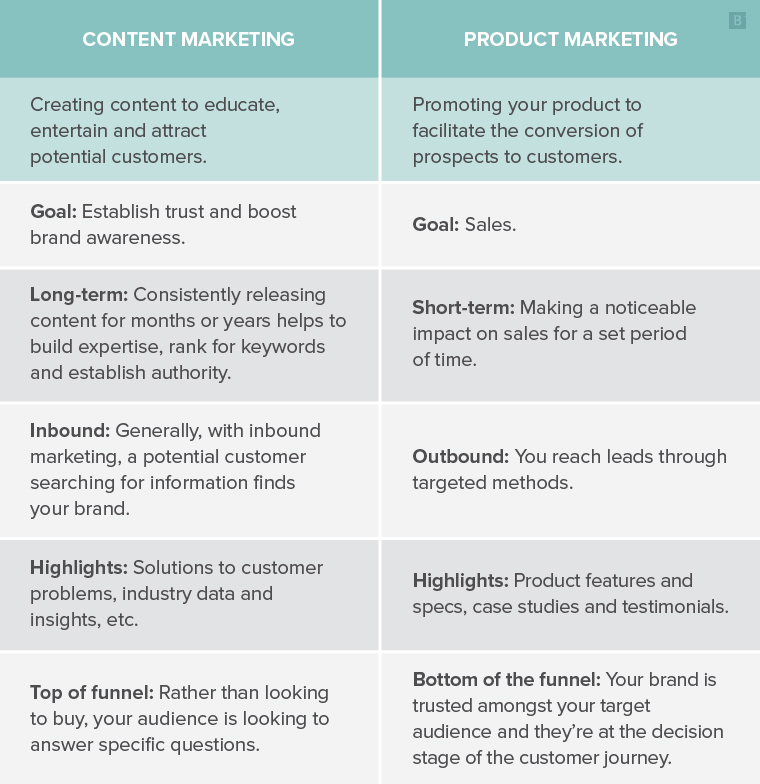The goal of any marketing strategy is to attract and convert members of your target audience into loyal, paying customers. But, that’s easier said than done.
Ultimately, a successful strategy lies in the thorough combination of understanding your target audience’s needs and giving them the information and content needed to drive them toward conversion. However, something you’ll have to consider along the way is the type of marketing to leverage — which often begs the question, “what’s the difference between content marketing and product marketing?”
We’re taking a closer look at the key elements that distinguish these marketing strategies, so you can gain a thorough understanding of your options and determine the type that best suits your current marketing needs.
Content Marketing vs. Product Marketing: What’s the Difference?
Both content marketing and product marketing can be extremely valuable tools for your brand when used in the right context. However, to do this successfully, you need to be able to differentiate these alternatives.
With product marketing, you’re trying to show potential customers what a specific product is, how it can help them, why it’s better than competing choices and why they should purchase now. This typically relies heavily on paid advertising to demonstrate the product experience and convert leads and prospects into sales. Content marketing, as an alternative, aims to highlight your expertise and show consumers what you know. This includes creating an engaging content strategy to reach your target audience effectively.
Overall, the main goal of content marketing is to build trust and foster brand awareness, while the purpose of product marketing is to facilitate sales. Take a look at this table for a quick overview of the differences to bear in mind:

With an end goal of conversions, product marketing requires thoughtful collaboration between your sales team, marketing team and customer success team. This cooperation helps your business develop valuable strategies to understand your target customers and improve product sales.
Contrarily, content marketing promotes brand authority and demonstrates expertise in a specific area. With this in mind, let’s take a closer look at when your brand is best-suited to use each strategy.
When is Product Marketing Appropriate?
Product marketing is, as you might assume, focused on your product. You’re essentially advertising your brand’s product in an attempt to boost traffic and move customers further down the sales cycle. This ultimately involves:
- Understanding the needs of your target audience.
- Introducing your unique selling points.
- Helping a potential customer recognize the benefits of your product over a competitor’s.
To approach this effectively and comprehensively, your product marketing content should cover everything from product launch — also known as your go-to-market strategy — to product positioning, messaging and how your customer understands and experiences it.
Product Marketing Channels To Consider
If you’re a marketing manager, you’re in luck: There are a number of channels you can use to support your product marketing strategy. One of the most popular forms of product marketing is PPC (pay-per-click) advertising through search engines and social media. Some of your other options to position your product, emphasize key features and establish its value proposition are as follows:
- Press releases.
- Sales decks.
- Paid ads.
- Case studies.
- Product sheets, spec diagrams and/or tear sheets.
- Landing pages.
- Infographics and blog posts.
The Key Advantages of Product Marketing to Note
- Increase sales: This may seem obvious, but it’s worth mentioning again. Product-oriented ads, in combination with efforts to improve customer understanding and create better solutions, enhance your ability to attract and convert customers.
- Enhance customer understanding: It’s almost impossible to have a successful product without establishing opportunities to improve customer understanding. Product marketing ensures you have a clear picture of your buyer persona, which helps you fine-tune your product messaging and positioning for the best results.
- Build better products and services: It’s simple, the best way to generate sales is to offer a well-optimized product. Throughout the product marketing process, you can discover the features and experiences users are looking for to shape your products and services for the best customer experience moving forward.
Subscribe to
The Content Marketer
Get weekly insights, advice and opinions about all things digital marketing.
Thank you for subscribing to The Content Marketer!
How Can Your Brand Embrace Content Marketing?
Content marketing, on the other hand, mainly involves creating and distributing useful, engaging content to:
- Boost brand awareness.
- Solve customer pain points.
- Drive traffic towards sales.
- Generate demand.
This type of marketing aims to provide users with content that’s informative, engaging and highly valuable to them. While driving purchases is always the ultimate intent, leveraging growth marketing is a proven technique to build personalized connections with your target audience. A 2021 Mckinsey & Company report found that personalization is highly important, with 78% of consumers being more likely to make repeat purchases from brands that deliver tailored experiences.
Content Marketing Channels To Leverage
Quality content is a linchpin in reaching your audience, keeping them engaged and leading them to take action. In other words, valuable content means better business results. But, if you’re not sure what content to create, where to share it or how to propel engagement, you’re not alone.
If you’re a content marketing manager in search of the channels available for successful content marketing, some of the most popular options are as follows:
- Website/blog.
- Social media.
- Q&A forums.
- Videos.
The Benefits of Successful Content Marketing
- Develop brand authority: When you consistently create and publish quality content — whether that be with a blog post, white paper or a YouTube video — it helps you build authority in the eyes of your target audience. In turn, you quickly become a trusted brand, which is a significant factor in gaining conversions.
- Establish strong brand-customer relationships: Creating more content means establishing a tone and personality that your prospective customers can understand and connect with. Continuous interactions from this point can help you develop stronger and longer-lasting brand-customer relationships.
- Improve your social media presence: Providing informative content on social media supports greater engagement and traction, which can help your brand establish a valuable online presence and community.
- Cost-efficiency: Content marketing is typically more cost-effective than other digital marketing and advertising strategies — holding longer-term value.
- Provides long-term returns: Unlike ads or other traditional marketing that disappears, your brand’s content has a longer digital shelf-life. This means your content lasts for as long as you let it, serving as a continuous source of brand awareness.

How Do Consumers React to Marketing Today?
When it comes to how consumers interact with marketing today, there are a few behavior trends for your business to watch as you foster a marketing strategy:
- Purchases preferences reflect a rise in people connecting with brands, browsing and shopping from home.
- Greater accessibility in terms of product options is making brand loyalty less secure.
- Temporary convenience options that surfaced in response to the pandemic are here for the long haul.
- Consumers are increasingly in pursuit of brands that align with their values and beliefs.
- Digital marketing strategies, particularly the use of AI and VR, are becoming more widely recognized and accepted by consumers each year.
You can’t always anticipate how your consumers will react to your marketing initiatives. But, as you build out your strategy, remember consumers today expect to be heard and they want the brands they care about to reciprocate the feeling.
As you assess your brand’s approach to marketing, it’s imperative to take your content marketing funnel into account. This helps you visualize how to effectively use valuable content to attract prospective customers and guide them through their journey — from initial interaction to conversion. Content creation in different stages is meant to support the customer journey and drive leads to a purchase.
The 4 stages of the content marketing funnel include:
- Awareness: Sometimes referred to as the top of your marketing funnel (TOFU), content in this stage should be informational and educational — introducing your brand to a prospective customer.
- Evaluation: The evaluation stage is in the middle of the funnel (MOFU), where potential consumers are familiar with your brand marketing and start considering whether your business would be a suitable fit.
- Conversion: With the ultimate goal of converting every possible consumer, marketers in this stage — at the bottom of the marketing funnel (BOFU) — can focus on content that’s designed as the final push for leads to become sales.
- Delight: After conversion, keep in mind the work’s not done quite yet! At this point, it’s essential to concentrate on retaining customers and building long-term loyalty.
In light of this, a robust content marketing strategy can address questions such as:
- Do I have a firm understanding of the brand’s buyer persona?
- What type of content should I create for an improved customer experience?
- What outcomes should my content achieve?
- How will I measure the success of my content?
- Where can I strengthen my content strategy?
How Do You Create a Balanced, Effective Marketing Strategy?
Your marketing strategy — whether you’re focusing on content or product marketing — is a valuable outline of your plan to achieve organizational goals by understanding your customer’s needs and establishing a distinct competitive advantage to promote conversion.
Here’s a quick overview of the steps you can take to foster a comprehensive marketing strategy to help you effectively reach your business goals.
- Set your marketing goals.
- Do a marketing analysis (including a marketing audit and market research).
- Identify your target audience and get to know them well.
- Know your product and resources inside and out.
- Outline marketing techniques and channels available to help you achieve your objectives.
- Create a marketing plan.
- Establish an evaluation process.
Content and product marketers are well aware of the amount of work required for every marketing endeavor — put simply, it can be a lot. But, with a comprehensive marketing strategy by your side, your brand can quickly drive the effectiveness of your promotional and sales activities. This helps you:
- Reach your target audience effectively.
- Optimize the use of your money and resources.
- Ensure consistent marketing efforts.
- Define measurable outcomes.
Sign up for our newsletter for a weekly update on the latest content marketing news.





